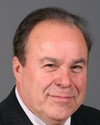There are 12 steps in this process. I mentioned earlier that they've already failed the standardized field sobriety test at the roadside. They go back to the police station, and then a person who is trained in drug recognition evaluation does a number of eye tests, looks at a number of clinical indicators, and has the person do divided attention tasks. One of the first things they're doing is looking at the eyes and looking to see whether or not the person has a head injury. So they're looking for medical conditions at the same time.
They go through this 12-step procedure. They then record all of the information on there. They're looking for things like pulse and blood pressure at different times. They do examinations of the eyes. They look at muscle tone. They have them go through the divided attention tasks, although there are five of them, rather than three, as is the case at the roadside. Whether or not they fail the divided attention tasks helps them determine whether the person is impaired. Then, based on the clinical indicators, they can determine whether there is a drug or a drug class—more than one—involved in causing that impairment. Impairment can also be alcohol mixed with drugs.
If they cannot make a call, or the person passes the divided attention tasks at that particular point in time, there would be no bodily fluid sample collected. The DRE has indicated that they have gone through the entire testing. Perhaps the person has a very short-acting drug, or perhaps the person is doing fine on the divided attention tasks at that particular point in time. The DRE would not continue. They would stop, and they would say this person is obviously not under the influence at this particular point in time.
So they have to go through the entire 12 steps. At the end of that they make a call: “Yes, this person's ability to operate a motor vehicle is impaired, and the reason for that impairment is a class of drugs”—and they identify the drug class. They don't identify the drug. They don't identify it as cocaine or methamphetamine; they identify it as a stimulant. A urine sample is collected and sent to the lab. I do not just test for stimulants; I test for all drugs. Therefore, if the person is under the influence of a depressant rather than a stimulant, it means that the call was incorrect and the case would not proceed to trial. I might find cocaine. I might fine methamphetamine. I might fine amphetamine. I might find ephedrine. I might find sudephedrine. These are all stimulants. It therefore corroborates the finding of the DRE.
So, yes, I actually feel there are a lot of checks and balances in this process and that people who are not under the influence of a drug would not get charged. There are lots of processes in place. They have to have the three steps. You have to have evidence of impaired driving in the first place. They have to have failed the standard field sobriety test. You have to have them go through a DRE, which again includes divided attention tasks. Then you have to have the bodily fluid sample, which corroborates the findings of the DRE. So there are lots of checks and balances in place.
The second part of your question had to do with the person's being a cigarette smoker. The DRE does not consider all drugs. There are lots of drugs out there that do not impair your ability to operate a motor vehicle. One of them would be nicotine that you find in cigarettes. Another would be caffeine. We don't worry about things like vitamins or antibiotics, or lots of other drugs. Not all drugs will impair your ability to operate a motor vehicle.
The DRE program is set up so it looks at seven classes of drugs that will affect your ability to operate a motor vehicle. So although I do a screen—and I look for everything; I look for things like acetaminophen, Tylenol, Aspirin—I'm really only interested in reporting the ones that impair your ability to operate a motor vehicle. However, the report will indicate all the other drugs that I found, and I will indicate that some of them do not impair your ability to drive. That's part of my job as a toxicologist.





